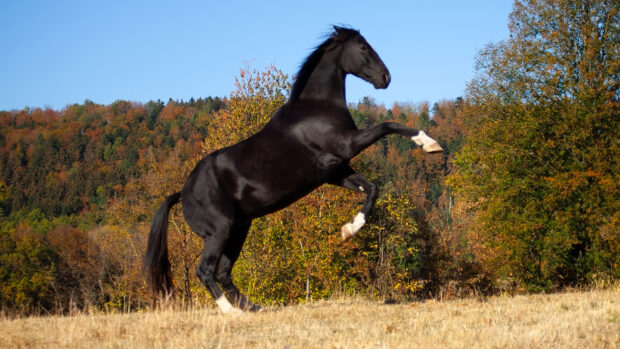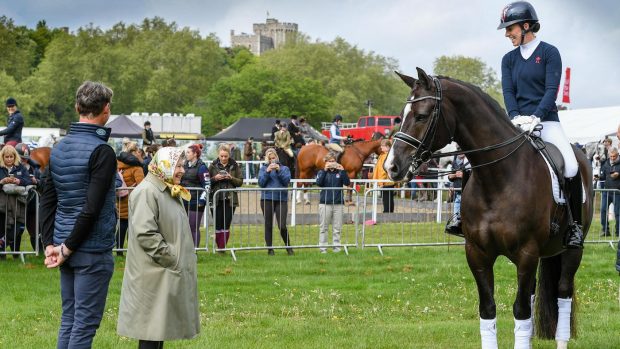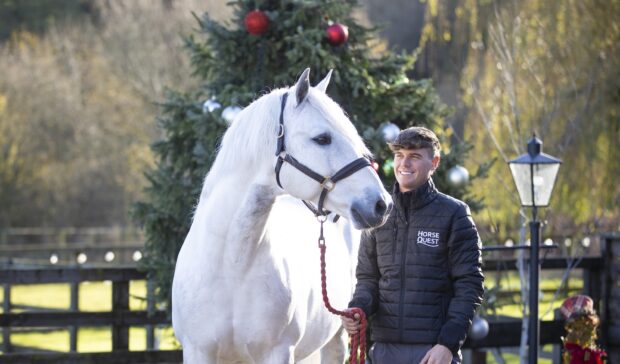As Horse & Hound celebrates its 140th anniversary, we are looking back at some of the biggest equine superstars of our history and the name Foxhunter will always be synonymous with showjumping
When Sir Harry Lewellyn and his showjumper Foxhunter left for the Helsinki Olympics in 1952, it’s probably fair to say that the majority of the British public had never heard of them.
Everything changed after the three-man showjumping team took Britain’s only gold medal of the Games, and they returned home to a wave of adulation. Most of this was aimed at Foxhunter, who jumped the winning clear round and simultaneously became a national equine hero.
Formerly called Eelskin
The showjumper best known as Foxhunter was bred at Corporation Farm in the Norfolk village of Hethel by Knyvett Millard. A bright bay with one white sock and a large, slightly Roman-nosed head, he was originally named Eelskin.
His name was changed by Leicestershire farmer Norman Holmes, who bought him as an unbroken four-year-old for £60 after being told by Millard that he had bred a promising horse.
Foxhunter could not have gone to a better man. Norman Holmes was a great producer and he brought the 16.3hh youngster on slowly until his potential was spotted by Sir Harry Llewellyn, a former top amateur jockey who had finished second and fourth in the Grand National before embarking on a distinguished military career.
An unusual search for a showjumping star
Harry changed sports after World War II, but he didn’t find his showjumper Foxhunter through the usual method. He made a painstaking search of the records of every horse registered with the British Show Jumping Association (now British Showjumping) before settling on Foxhunter and persuading Norman Holmes to part with the gelding at the end of his sixth year for £1,500 (around £63,000 today).
It was an inspired choice, as from the start the pair couldn’t stop winning. In a short international career that lasted only until 1956, among their major achievements was when Foxhunter entered the record books as the first and only horse to win three King George V Gold Cups.
Foxhunter was only an eight-year-old when he and Harry were selected for the 1948 London Olympics. The showjumping was held at Wembley and 44 riders from 15 nations tackled a 16-fence course of fences up to 1.60m. With team-mates Henry Nicoll (Kilgeddin) and Arthur Carr (Monty), Harry and Foxhunter took home a bronze medal behind Mexico and Spain.
A second Olympics

Foxhunter at the International Horse Show at White City in 1951.
Foxhunter and Harry then blazed a trail throughout the sport at home and abroad and four years later, they were off to their second Olympics in Helsinki with high hopes.
It all went wrong in the first round of the team competition, but their comeback was in true Boy’s Own Paper style. Harry and Foxhunter both had a snooze between the rounds and by the time they entered the ring for the second time, a four-fault round from Foxhunter would be enough for gold. Hopes weren’t high, but horse and rider showed complete composure en route to a clear and a place in showjumping history.
Harry was always embarrassed by the press treatment after Helsinki, which made it look as though he had single-handedly won gold, saying: “Foxhunter performed the least well of all the horses, but we got all the praise, a point I made repeatedly to anyone who would listen.”
He later went on to write in his autobiography: “I had failed to warm up Foxhunter adequately before round one. The team was lying only sixth at halfway and it was all my fault. I was shattered.”
In 1954, Harry decided to turn his showjumping superstar into a hunter in the off-season.
“We had two marvellous seasons hunting. I could jump anything on him – water, huge rails – you really could have fun,” he said.
Retirement beckoned
They combined showjumping and hunting until 1956. At Dublin that year, Foxhunter won the first and last classes at the show, after which he was immediately retired.
“He went out at the top,” said Harry at the time.
Harry was by now master of the Monmouthshire hunt and continued hunting Foxhunter, but he could tell that something wasn’t right.
“He began tiring quickly and I decided to leave him in the field before the 1959-60 season,” he said.
Foxhunter didn’t have much time left, as he died on 28 November 1959, aged 19. Such was his fame that his death was reported in a Pathe newsreel.
“He had a ruptured artery to his kidneys and died very quickly,” explained Harry. “Shortly afterwards we decided on his burial. I owned some land on Blorenge mountain and right at the top are some rocks. Here, we found a cavity into which we put a stainless steel casket. In this was placed a book I had written, Foxhunter in Pictures, and his hide. His skeleton was preserved and went to the Royal Veterinary College.”
A fitting memorial
A memorial plaque over the grave high in the Welsh mountains between Abergavenny and Blaenavon now marks Foxhunter’s greatest achievements. The great horse’s name also lived on through the now world-famous series for novice showjumpers, the Welsh pony stud Harry set up at his home and a chain of Foxhunter restaurants and cafes he founded.
Harry went on to hold several administrative posts at the British Show Jumping Association and was chairman of the association from 1967 to 1969. In 1968, he returned to the Olympics as chef d’equipe for the British showjumping team in Mexico City.
When he died in 1999, Harry Llewellyn’s ashes were scattered around the grave of his old equine friend.
“I think he was the greatest jumper ever,” he said after Foxhunter’s retirement. “Of course, every rider thinks his horse is the best but Foxhunter could do everything. I never saw another horse that could compare to him.”
Foxhunter fact file
Name: Foxhunter (formerly Eelskin)
Breeder: Knyvett Millard
Born: 23 April 1940 (St George’s day)
Sire: Erehwemos (Somewhere, spelled backwards), an HIS Premium thoroughbred stallion
Dam: Catcall, a Clydesdale/thoroughbred mare
Living life with showjumper Foxhunter
In a 2014 interview for the People’s Collection of Wales, Harry Llewellyn’s son Roddy recalled the relationship between Foxhunter, his father and the public.
“My father understood horses. I think most successful competitive horse people have that special relationship and my father certainly did with Foxhunter. Foxhunter was an extraordinary, exceptional horse. He was so quiet that he used to have his mane plaited lying down in a stable. I remember as a child almost being able to talk to him; he was like an uncle to me and it was agony when he died.
“Busloads of children came to visit Foxhunter. One little girl touched Foxhunter and she stared at her hand and said: ‘I’ll never wash again!’ He was a national treasure. He appeared at all the county shows around England. He was led around the ring because people just wanted to see him.”
Foxhunter’s showjumping legacy
The Foxhunter championship may be something many British showjumpers dream of winning, but the class had a low-key start after Harry tried to think of a way to use up some of the countless trophies he and Foxhunter had won. The competitions ran for around four years in South Wales before becoming a national series in 1954.
“The class mushroomed more than I ever thought it would. The fences were set at 3ft 6in [around 1.10m] in round one and the idea was to attract more hunting people into showjumping,” said Harry at the time.
Exeter riding school owner Frances Stanbury won the first Horse of the Year Show final on Dreamboat, and since then the Foxhunter champions have included some top names.
Among them was Beethoven, who took the 1962 title as a four-year-old for Douglas Bunn and went on to win the World Championship. Pennywort, who won for Paula Graham in 1970, was the granddam of the incomparable Milton, while John Popely’s 1999 champion Luidam and Marius Claudius, winner the following year with Robert Smith, both became world-renowned stallions.
The 2001 champion Mondriaan fulfilled a long-held ambition for William Funnell by winning the Hickstead Derby, and Sultan, who took the 2009 title for Bruce Menzies, helped Saudi Arabia to team bronze at London 2012.
If he were alive today, Harry Llewellyn would be proud. The champions may not have come from the hunting field, but the class has become a fitting legacy for one of the greatest showjumping horses of all time.
Foxhunter’s story at the Helsinki Olympics
In the days of the Helsinki Olympics, teams were made up of three riders with all scores to count. The British trio travelled there more in hope than expectation. There were 20 nations entered, and the team and individual championships both took place on the final day of the Games.
The first round started at 8am, which meant a 5am start for grooms and riders. The course was not considered as daunting as that built for the 1948 London Games but there were plenty of problems around the 13-fence track. The fences were up to 1.60m and all at least 15ft long, with the poles painted white and natural fillers. There were few decorations and the only coloured fence was an oxer of yellow planks.
Duggie Stewart and Aherlow led off for Britain with 12 faults. As the best score at that stage was eight, this was considered satisfactory. Wilf White and Nizefela then jumped a brilliant round, with just four faults at the gate. This left Britain joint second, one fence behind the Italian leaders.
Sensationally, Italy dropped out after third rider Lt Piero d’Inzeo was eliminated for not being ready to jump. However, things didn’t go right for Britain either.
Harry and Foxhunter jumped the first four fences perfectly before faulting at the plank parallel. Foxhunter then slowed into the double, which they somehow cleared. He jumped the following wall almost from a standstill, leaving Harry clinging to his side. Harry struggled back into the saddle, but Foxhunter stopped at the next fence and also lowered the gate to finish on 16.75 faults.
Harry blamed himself, as he had jumped only three practice fences in an effort to keep Foxhunter fresh.
“As soon as we entered the ring, Foxhunter started looking all over the place and acting as though every fence concealed the devil,” he said.
The second round began at 3.15pm in front of 70,000 spectators and four-fault rounds from Duggie Stewart and Wilf White left Britain in the lead with one horse to jump.
It was all down to Harry Llewellyn and Foxhunter and British supporters’ hearts were in their mouths, but it was a different horse and rider this time. Foxhunter seemed to realise how much depended on him and cleared everything easily to secure the gold medal.
Foxhunter facts in numbers
- 78 international wins
- 35 British Nations Cup teams
- 5 Prince of Wales Cups
- 4 winning Aga Khan Cup appearances in Dublin
- 3 King George V Gold Cups
- 2 Olympic team medals
You might also enjoy reading…

Horse & Hound’s 140th anniversary legends: Milton – John Whitaker’s wonder horse who won over £1m during his career

Legends of the sport: Olympic gold medal-winning showjumper Nick Skelton *H&H Plus*
The great showjumper gilded an already exceptional career with gold in Rio in 2016. Jennifer Donald traces the steps that

Legends of the sport: ‘Outspoken and phenomenal’ showjumper Harvey Smith

Legends of the sport: Showjumper Marion Mould with her pony Stroller *H&H Plus*
The teenage girl on a pony that conquered the world stage has become the stuff of showjumping legend. Penny Richardson

Legends of the sport: The showjumping career of Ann Moore *H&H Plus*
The enigmatic young showjumper who stole the hearts of a nation by winning silver at the 1972 Munich Olympics turns

Subscribe to Horse & Hound magazine today – and enjoy unlimited website access all year round
Horse & Hound magazine, out every Thursday, is packed with all the latest news and reports, as well as interviews, specials, nostalgia, vet and training advice. Find how you can enjoy the magazine delivered to your door every week, plus options to upgrade your subscription to access our online service that brings you breaking news and reports as well as other benefits.



